Observing the Eclipse of Jovian Satellites during 2008 -
Star Party Presentations for 111W Longitude - demonstration center RA19h Dec-23° - Jupiter - 3° radius
K. Fisher fisherka@csolutions.net Rev. 1/24/2008A Orig. 1/24/2008
Purpose
|
Watch Jupiter during one of 18 eclipse opportunities between May and November 2008 from observing points near 111W longitude. View a Jovian satellite pop into or disappear from view during a Jovian eclipse emersion or immersion some distance from Jupiter's disk using binoculars or any class of telescope. Alternatively, using a planetary imaging camera, make a movie of a Jovian satellite eclipse event.
While single and rarer double satellite transit
events one of the more popular Jovian observing pasttimes, another category of event - Jovian satellite eclipses are also interesting.
|
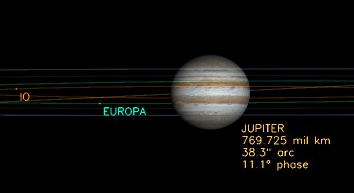
Jupiter from Earth on 9-23-2008 2:45UT just before Io eclipse reappear event Fig. 1 - Image courtesy of NASA/JPL Solar System Simulator
|
Eighteen eclipse opportunities were extracted from the RASC 2008 Observer's Handbook that apply to the author's observing point at 111W longitude, 41N latitude. Supplemental ephemeris data was gathered into three tables, below. Table 1 lists the events.
For events prior to August, beginner to advanced planetary imagers may want to consider making a movie of a Jovian satellite emersion and immersion events. Searching the web, there do not appear to be internet movies of such eclipse events, except for a movie made from a 2001 Cassini flyby of Io.
Amateurs who do make movies of the events listed in Table 1 are requested to forward a copy or a url link to this author for inclusion in the right-hand column of Table 1.
This sky party presentation cheat sheet was originally conceived as an observing list for school and scout parties. Kids in urban areas typically have binoculars and light-polluted urban skies, cannot see Jovian cloud detail, but can easily see the Jovian moons. Observing during an eclipse emersion event would allow them to see another active astronomical event, like a moving comet, instead of star hopping for static objects, like globular clusters. These events also provide a supplemental real world exercise when studying basic solar system orbits.
For school or scout star party support before August, this star party presentation cheat sheet and the observing opportunties are not suitable for children, as the observing opportunities are after midnight. After August, observing opportunities are before midnight and are better suited for school-aged children.
In general, Table 1 should be reproduced and distributed as a handout at public star parties when Jupiter first becomes visible at your observing point. Amateurs can use it as a reference list of future observing opportunities. An animation of orrey views in Table 1 is also available. The animation shows the relative motions of the Earth and Jupiter across six months of observing events. (1.4megs). All of the views in Table 1 also can be seen as a Microsoft PowerPoint slideshow. (3.2 megabytes). The Sky and Telescope Jupiter's Moons Javascript Calculator (accessed Jan. 23, 2008) can be used to further investigate the positions of the Jovian Moons. The calculator includes a relative position image that simulates a telescopic view of the immersion and emersion of Jovian satellites from Jupiter's shadow, including direct, single, and double reversed eyepiece views.
Observing list
Table 1 - Jovian Moon eclipse opportunities for 2008 from 111W Longitude (N. Am., U.S., Intermountain Region)
| Satellite | Type | Time_Mtn | Time_UT | Time_Helio | View_Orrey | View_Earth | View_Jupiter | Image_actual |
| Callisto IV | EcR | 5/5/2008 4:12 | 5/5/2008 10:12 | 5/5/2008 9:33 | 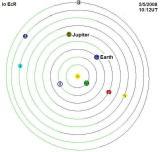 |  |  | none until event |
| Ganymede III | EcD | 6/12/2008 2:45 | 6/12/2008 8:45 | 6/12/2008 8:10 | 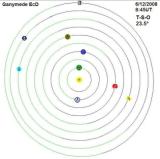 |  |  | none until event |
| Io I | EcD | 6/12/2008 3:31 | 6/12/2008 9:31 | 6/12/2008 8:56 | 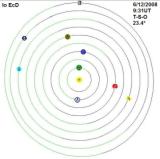 |  |  | none until event |
| Io I | EcR | 7/14/2008 2:19 | 7/14/2008 8:19 | 7/14/2008 7:45 |  |  |  | none until event |
| Io I | EcR | 7/22/2008 22:42 | 7/23/2008 4:42 | 7/23/2008 4:08 | 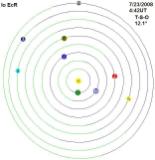 |  |  | none until event |
| Callisto IV | EcR | 7/27/2008 22:56 | 7/28/2008 4:56 | 7/28/2008 4:21 | 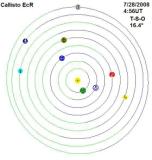 |  |  | none until event |
| Io I | EcR | 7/30/2008 0:36 | 7/30/2008 6:36 | 7/30/2008 6:01 | 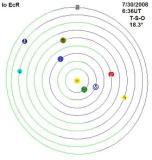 |  |  | none until event |
| Europa II | EcR | 8/9/2008 21:32 | 8/10/2008 3:32 | 8/10/2008 2:57 | 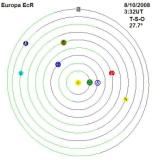 |  |  | none until event |
| Io I | EcR | 8/14/2008 22:54 | 8/15/2008 4:54 | 8/15/2008 4:18 | 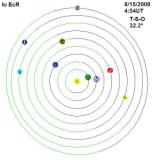 |  |  | none until event |
| Europa II | EcR | 8/17/2008 0:09 | 8/17/2008 6:09 | 8/17/2008 5:33 |  |  |  | none until event |
| Ganymede III | EcD | 8/29/2008 22:37 | 8/30/2008 4:37 | 8/30/2008 4:00 | 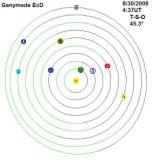 |  |  | none until event |
| Io I | EcR | 8/30/2008 21:13 | 8/31/2008 3:13 | 8/31/2008 2:36 | 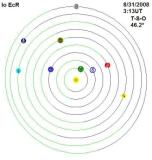 |  |  | none until event |
| Io I | EcR | 9/6/2008 23:08 | 9/7/2008 5:08 | 9/7/2008 4:30 | 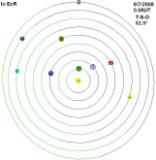 |  |  | none until event |
| Europa II | EcR | 9/10/2008 21:20 | 9/11/2008 3:20 | 9/11/2008 2:42 | 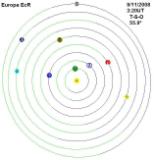 |  |  | none until event |
| Io I | EcR | 9/22/2008 21:27 | 9/23/2008 3:27 | 9/23/2008 2:47 |  |  |  | none until event |
| Io I | EcR | 10/8/2008 19:47 | 10/9/2008 1:47 | 10/9/2008 1:05 | 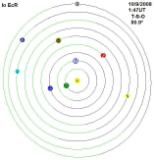 |  |  | none until event |
| Europa II | EcR | 10/12/2008 21:06 | 10/13/2008 3:06 | 10/13/2008 2:24 | 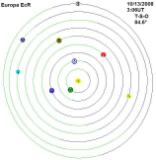 |  |  | none until event |
| Io I | EcR | 10/31/2008 20:02 | 11/1/2008 2:02 | 11/1/2008 1:17 |  |  |  | none until event |
Table 1 Notes:
- EcR or EcD - Eclipse reappear event; eclipse disappear event.
- Time_Mtn - Mountain Daylight Time of the Jovain eclipse event.
- Time_UT - Universal Time of the event as seen from Earth.
- Time_Helio - The heliocentric reference time of the event at Jupiter without a light-speed time delay. This time was used to generate simulated views of the event using the NASA/JPL Solar System Simulator.
- View_Orrey - An equal radius orrey view of solar system planets, courtesy of the John Walker's Home Planet desktop and his Your Sky online planetarium software. This view is used to visualize the relative position of the Earth to Jupiter at the time of an eclipse event. The orrey is an equal radius projection, not a real position projection, and only approximates the true Target(Jupiter)-Sun-Observer(Earth) angle.
- View_Earth - A simulated direct view of Jupiter and its satellites courtesy of the NASA/JPL Solar System Simulator. This application does not include simulation of Jupiter's shadow. Although these simulated views are good indicators of what Jovian satellites may be visible at the time of the event and of their positions, some satellites my be eclipsed in Jupiter's shadow and may not be visible. The NASA/JPL simulated view shows the likely eyepiece view just after satellite emersion or just before imersion. The simulated view is rendered at the heliocentric time of the event, before the light-speed time delay caused by the Earth's distance from Jupiter. Conversely, the Sky and Telescope Jupiter's Moons Javascript Calculator simulates the immersion and emersion of Jovian satellites from Jupiter's shadow.
- View_Jupiter - A simulated direct view of Jupiter as seen from the eclipsed Jovian satellite courtesy of the NASA/JPL Solar System Simulator. This view was used to confirm that an eclipse event was in progress at the indicated time. Note the simulated view is rendered at the heliocentric time of the event, before the light-speed time delay caused by the Earth's distance from Jupiter. For the first three events, the simulated view of Jupiter is as that planet is seen from above the ecliptic plane from the Ulysses circum-solar satellite.
- Image_actual - Reserved for linking future actual amateur images of each event.
Visualizations and supplemental data
An orrey animation showing the relative motions of the Earth and Jupiter across six months of observing events is available. (1.4megs). All of the views in Table 1 also can be seen as a Microsoft PowerPoint slideshow. (3.2 megabytes).
Table 2 - Jovian Moon eclipse events from 111W Longitude, 41N Latitude - Horizon and celestial coordinates
| Satellite | Time_UT | Sun_alt | Jup_Alt | Jup_Az | Jup_Ra | Jup_Dec |
| Callisto IV | 5/5/2008 10:12 | -41.1 | 21.9 | 150.6 | 19 35 56.11 | -21 39 02.0 |
| Ganymede III | 6/12/2008 8:45 | -23.5 | 26.3 | 167.6 | 19 29 18.94 | -21 59 11.4 |
| Io I | 6/12/2008 9:31 | -19.9 | 27.3 | 179.6 | 19 28 47.05 | -22 00 06.2 |
| Io I | 7/14/2008 8:19 | -26.7 | 24.7 | 197.4 | 19 12 33.90 | -22 35 59.1 |
| Io I | 7/23/2008 4:42 | -17.4 | 21.7 | 153 | 19 07 50.54 | -22 45 03.4 |
| Callisto IV | 7/28/2008 4:56 | -19.9 | 24.3 | 161.7 | 19 05 21.62 | -22 49 47.5 |
| Io I | 7/30/2008 6:36 | -29.3 | 25.8 | 189.4 | 19 04 19.98 | -22 51 27.3 |
| Europa II | 8/10/2008 3:32 | -10.9 | 22.2 | 155.2 | 18 59 43.84 | -22 59 31.8 |
| Io I | 8/15/2008 4:54 | -24.2 | 26.2 | 180.9 | 18 57 58.95 | -23 02 26.3 |
| Europa II | 8/17/2008 6:09 | -32.66 | 23.1 | 201.9 | 18 57 22.36 | -23 03 31.4 |
| Ganymede III | 8/30/2008 4:37 | -26.6 | 25.1 | 192.5 | 18 55 11.58 | -23 07 45.4 |
| Io I | 8/31/2008 3:13 | -13.7 | 25.7 | 172.1 | 18 54 32.95 | -23 08 26.7 |
| Io I | 9/7/2008 5:08 | -33.6 | 20.95 | 207.6 | 18 54 06.61 | -23 09 32.7 |
| Europa II | 9/11/2008 3:20 | -18.4 | 25.92 | 185.08 | 18 54 11.01 | -23 09 46.4 |
| Io I | 9/23/2008 3:27 | -23.8 | 23.91 | 198.3 | 18 55 39.16 | -23 08 33.7 |
| Io I | 10/9/2008 1:47 | -10.3 | 25.8 | 187.8 | 19 00 33.25 | -23 02 39.6 |
| Europa II | 10/13/2008 3:06 | -26.25 | 20.05 | 210.3 | 19 02 18.75 | -23 00 20.0 |
| Io I | 11/1/2008 2:02 | -19.9 | 20.3 | 210.4 | 19 12 47.24 | -22 44 23.2 |
Table 3 - Jovian Moon eclipse events from 111W Longitude - Lightspeed delay and helocentric coordinates
| Satellite______ | Time_UT________ | One-way Light-time (mins) | Dist. Earth Jovian Moon (km) | Dist. Earth Jovian Moon (au) | Mag | S-O-T | S-O-T Type | S-T-O | T-S-O | hEcl-Lon Jmoon | Dist. JMoon (au) | hEcl-Lon Earth | Dist. Sun-Earth (au) |
| Callisto IV | 5/5/2008 10:12 | 39.40 | 708679026 | 4.74 | 6.30 | 112.97 | L | 10.27 | 56.76 | 281.94 | 5.21 | 225.18 | 1.01 |
| Ganymede III | 6/12/2008 8:45 | 35.62 | 640632026 | 4.28 | 4.83 | 151.13 | L | 5.42 | 23.45 | 285.09 | 5.19 | 261.64 | 1.02 |
| Io I | 6/12/2008 9:31 | 35.58 | 639944506 | 4.28 | 5.34 | 151.16 | L | 5.42 | 23.42 | 285.09 | 5.19 | 261.67 | 1.02 |
| Io I | 7/14/2008 8:19 | 34.65 | 623223929 | 4.17 | 5.07 | 174.56 | T | 1.06 | 4.38 | 287.77 | 5.18 | 292.15 | 1.02 |
| Io I | 7/23/2008 4:42 | 34.83 | 626442315 | 4.19 | 5.19 | 165.03 | T | 2.90 | 12.08 | 288.51 | 5.18 | 300.59 | 1.02 |
| Callisto IV | 7/28/2008 4:56 | 35.09 | 631204428 | 4.22 | 6.70 | 159.66 | T | 3.90 | 16.44 | 288.93 | 5.18 | 305.38 | 1.02 |
| Io I | 7/30/2008 6:36 | 35.10 | 631413480 | 4.22 | 6.26 | 157.44 | T | 4.31 | 18.25 | 289.11 | 5.17 | 307.35 | 1.02 |
| Europa II | 8/10/2008 3:32 | 35.76 | 643198975 | 4.30 | 5.39 | 145.96 | T | 6.29 | 27.74 | 290.02 | 5.17 | 317.77 | 1.01 |
| Io I | 8/15/2008 4:54 | 36.12 | 649770060 | 4.34 | 5.22 | 140.71 | T | 7.12 | 32.17 | 290.45 | 5.17 | 322.62 | 1.01 |
| Europa II | 8/17/2008 6:09 | 36.30 | 653035825 | 4.37 | 5.42 | 138.59 | T | 7.44 | 33.97 | 290.62 | 5.17 | 324.59 | 1.01 |
| Ganymede III | 8/30/2008 4:37 | 37.54 | 675211701 | 4.51 | 4.93 | 125.53 | T | 9.15 | 45.32 | 291.70 | 5.17 | 337.02 | 1.01 |
| Io I | 8/31/2008 3:13 | 37.60 | 676389921 | 4.52 | 5.35 | 124.56 | T | 9.26 | 46.18 | 291.79 | 5.16 | 337.98 | 1.01 |
| Io I | 9/7/2008 5:08 | 38.37 | 690264814 | 4.61 | 5.41 | 117.59 | T | 9.96 | 52.45 | 292.39 | 5.16 | 344.84 | 1.01 |
| Europa II | 9/11/2008 3:20 | 38.84 | 698617151 | 4.67 | 5.58 | 113.80 | T | 10.28 | 55.93 | 292.72 | 5.16 | 348.65 | 1.01 |
| Io I | 9/23/2008 3:27 | 40.28 | 724507312 | 4.84 | 5.54 | 102.42 | T | 10.96 | 66.62 | 293.74 | 5.15 | 0.36 | 1.00 |
| Io I | 10/9/2008 1:47 | 42.30 | 760891444 | 5.09 | 5.64 | 87.89 | T | 11.18 | 80.94 | 295.09 | 5.15 | 16.03 | 1.00 |
| Europa II | 10/13/2008 3:06 | 42.83 | 770435816 | 5.15 | 5.79 | 84.28 | T | 11.12 | 84.60 | 295.43 | 5.15 | 20.03 | 1.00 |
| Io I | 11/1/2008 2:02 | 45.16 | 812347522 | 5.43 | 5.76 | 67.84 | T | 10.30 | 101.86 | 297.04 | 5.14 | 38.90 | 0.99 |
Table 3 Notes:
- One-way Light-time (mins) - Time in minutes that light takes to travel between the Jovian Satellite and the observer on the Earth. Light travels at about 299,792,458 meters per second (17,987,547 kilometers per minute).
- Dist. Earth Jovian Moon (km) - Distance between the observer on Earth and the Jovian moon in kilometers.
- Dist. Earth Jovian Moon (au) - Distance between the observer on Earth and the Jovian moon in astronomical units - mean Earth-Sun distance. There are about 149,597,871 kilometers in an astronomical unit.
- S-O-T - The co-planar angle in degrees between the Sun, the observer on the Earth, and the target - a Jovian moon. Ecliptic latitude changes for Jupiter and the Earth are neglible for the purpose of these tables and are not listed.
- S-O-T Type - Whether the satellite moon is leading or trailing Jupiter.
- S-T-O or Phase angle - The co-planar angle in degrees between the Sun, the target - a Jovian moon - and the observer on the Earth. This phase angle defines the apparent phase of a planet or its satellite as seen from the Earth.
- T-S-O - The co-planar angle in degrees between the target - a Jovian moon -, the Sun, and the observer on the Earth. The sum of the three co-planar angles (SOT, STO, and TSO equals 180°.
- hEcl-Lon Jmoon - Heliocentric ecliptic longitude in degrees of the Jovian moon. This column and the remaining columns to the right can be used by school children to construct a diagram of the relative positions of the Earth, Jupiter and the Sun using a ruler and protractor. The resulting Sun-Earth-Jovian-moon angles, listed above, can be measured using data in the columns to the left of this column.
- Dist. JMoon (au) - Heliocentric distance in a.u. between the Jovian moon and the Sun.
- hEcl-Lon Earth - Heliocentric ecliptic longitude in degrees of the Earth.
- Dist. Sun-Earth (au) - Heliocentric distance in a.u. between the Jovian moon and the Earth.
Table 4 - Jovian major moons - periods and semi-major axes
| Satellite | Period (days) | Mean semi-major axis (km) | Period^2 | Semi-major-axis^3 |
|---|
| Io I | 1.77 | 421800 | 3.1 | 7.50E+16 |
| Europa II | 3.55 | 671100 | 12.6 | 3.02E+17 |
| Ganymede III | 7.16 | 1070400 | 51.3 | 1.23E+18 |
| Callisto IV | 16.69 | 1882700 | 278.6 | 6.67E+18 |
Use
Table 1 should be reproduced and distributed as a handout at public star parties when Jupiter first becomes visible at your observing point. Amateurs can use it as a reference list of future observing opportunities.
Table 1 lists 18 opportunties for observing Jovian eclipse events extracted from the 2008 RASC Handbook and particularlized for the United States Intermountain Region. The date of each eclipse event is provided at Mountain Daylight, Universal, and Heliocentric Time.
There are suprizingly few observable Jovian eclipse events throughout a year (other than Io) for any one geographic location. All events in Table 1 were chosen based on their visibility in the U.S. Intermountain Region near 111W longitude (Idaho, Utah, Arizona). Some of the events before July may be observable from the Central Mountain Time zone (Colorado). During and after September, some events may be observable from the Pacific Time zone (California) during twilight.
Tables 2 and 3 provides supplemental ephemeris data for each event. Heliocentric coordinates in Table 3 can be used by school children to construct a diagram of the relative positions of the Earth, Jupiter and the Sun using a ruler and protractor.
Before leaving for a night's observing, a watch should be synchronized to an accurate universal time source, such as the USNO Time Service Department. It is easy to miss a timed event if your observing watch is off by five or ten minutes.
Discussion topics
Star party presenters can re-enforce observations at the eyepiece with the orrey animation and the data and simulated images in Table 1 in order to discuss the following principles:
- Opposition and quadrature: The opposition of Jupiter occurs on July 9. The eclipse event on July 14 occurs just past opposition. Quadrature occurs near the September 23rd event.
- Phase angle for a superior planet: The phase angle (S-T-O angle) of planet relative to Earth defines the position of the terminator. Compare the view at opposition (no terminator on Jupiter) with the near quadrature event on Nov. 1. (See the T-S-O angle in Table 3 for Nov.1).
- Leading verses trailing eclipses: Leading eclipses occur in the general order of EcD-OcD-EcR-OcR. (OcD=disappear (immersion) into occultation; OcR=reappear (emersion) from occultation). Trailing eclipse events have the order EcR-OcD-EcD-OcR. Closer to quadrature, the higher the angle that the event is seen from Earth, and the more likely it is that a full EcD-EcR eclipse shadow transit will be seen before an occultation occurs.
- Light time delay between Jupiter and Earth: As shown in the third column of Table 3, the one-way light time between the Jovian satellites and the Earth varies from a low of about 34.6 minutes near opposition to a high of 45.2 minutes. These variations are caused by the interaction between the finite speed of light of 299,792,458 meters per second (or 17,987,547 kilometers per minute) and the increasing distance between Jupiter and the Earth between July 14 and November 1 (812,347,522 km (5.43 au) minus 623,223,929 km (4.17 au) equals 189,123,592 km or about 10.5 (45.16-34.65) light-minutes. This increasing distance after opposition is shown in the orrey animation. As a consequence of the increasing one-way light time, the apparent period of Jupiter's outer major moon - Callisto IV - varies by about 10 minutes - small portion of its period shown in Table 4.
- Römer's 1676 estimate of the speed-of-light: After the popularization of the telescope by Galieo, various observers noticed the variation in orbital period of Callisto IV. Based on over forty eclipse events of the Jovian moon Callisto IV across a range of ecliptic longitudes, Römer first made the proper attribution of the cause of variation in Callisto's period to the speed-of-light and the changing distance between Jupiter and the Earth. He estimated the speed-of-light in terms of a number of Earth diameters - in modern equivalents around 140,000,000 meters per second. His estimate is low by modern standards but remarkable accurate for the tools of his era.
- Kepler's Third Law: Kepler's Third Law can be illustrated using the data in Table 4. Kepler's Third Law states that the squares of the orbital periods of planets are directly proportional to the cubes of the semi-major axes of their orbits. Stated mathematically, for any two bodies orbiting a central body: (T1/T2)^2 = (a1/a2)^2.
Table 5 - Kepler's Third Law Demonstration - ratio of the squared periods - per Table 4
| | Io I | Europa II | Ganymede III | Callisto IV |
| Io I | 1.0 | 0.2 | 0.1 | 0.01 |
| Europa II | 4.0 | 1.0 | 0.2 | 0.05 |
| Ganymede III | 16.4 | 4.1 | 1.0 | 0.18 |
| Callisto IV | 88.9 | 22.1 | 5.4 | 1.00 |
|
Table 6 - Kepler's Third Law Demonstration - ratio of the cubed semi-major axis distances - per Table 4
| | Io I | Europa II | Ganymede III | Callisto IV |
| Io I | 1.0 | 0.2 | 0.1 | 0.01 |
| Europa II | 4.0 | 1.0 | 0.2 | 0.05 |
| Ganymede III | 16.3 | 4.1 | 1.0 | 0.18 |
| Callisto IV | 88.9 | 22.1 | 5.4 | 1.00 |
|
References and sources
Bogan, Larry. 2008. Phenomena of Jupiter's Galilean Satellites. In Royal Astronomical Society of Canada. 2008. RASC Observer's Handbook 2008. pp. 214-220. (Emphemeris of eclipse events).
Römer, O. 1677. A Demonstration concerning the Motion of Light, Communicated from Paris . . . Philosphical Transactions, vol. 12. In Bartusiak, M. 2004. Archives of the Universe: A Treasury of Astronomy's Historic Works of Discovery. Pantheon. New York. pp. 117-119. (Römer's 1676 experiment estimating the speed-of-light based on observed changes in the orbital periods of Jovian satellites).
Schlosser, W., Schmidt-Kaler, T. Milone, E.F. 1991. Challenges of Astronomy.. Springer-Verlag. 1991cahe.book.....S
(Estimating the orbital period of Jovian satellites.)
Seronik, G. and Ashford, A.R. 2008. Chasing the Moons of Jupiter. Web article. Sky and Telescope. Url: http://www.skyandtelescope.com/observing/objects/javascript/3307071.html (accessed Jan. 23, 2008).
Sky and Telescope. 2008. Jupiter's Moons Javascript Calculator. Web application. Sky and Telescope. Url: http://www.skyandtelescope.com/observing/objects/javascript/jupiter (accessed Jan. 23, 2008).
Acknowledgements
NASA/JPL Solar System Simulator: This project has made use of the NASA/JPL Solar System Simulator to generate simulated images of the Jupiter.
NASA/JPL Horizons ephemeris application: This project has made use of the NASA/JPL Horizons Ephemeris generator to obtain Jovian ephemeris data included in Table 1.
John Walker's Home Planet planetarium software: This project has made use of John Walker's Home Planet desktop and his Your Sky to generate equal radius orrey images of the solar system.
Disclaimers
Amateur content
This website contains amateur astronomer developed materials.
No copyright asserted
No copyright is asserted to any original content materials developed and included by this author in this document and the same are released to the public domain. No copyright is asserted as to any scientific fact recited herein or to any external content materials incorporated in this document.



































